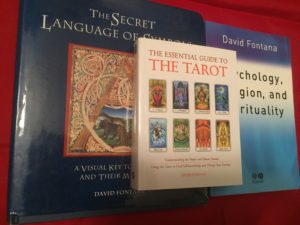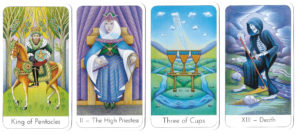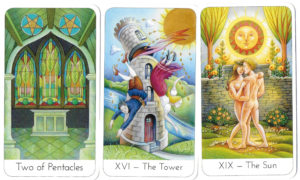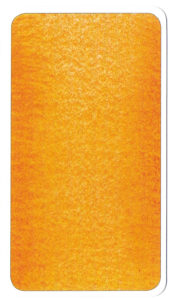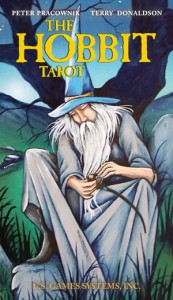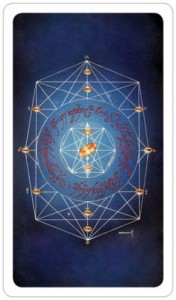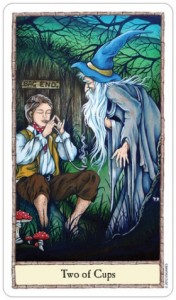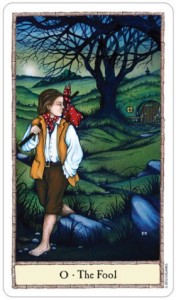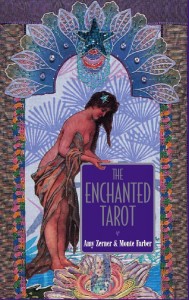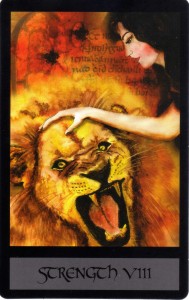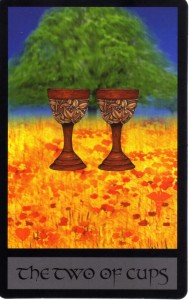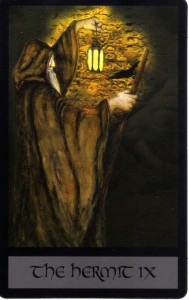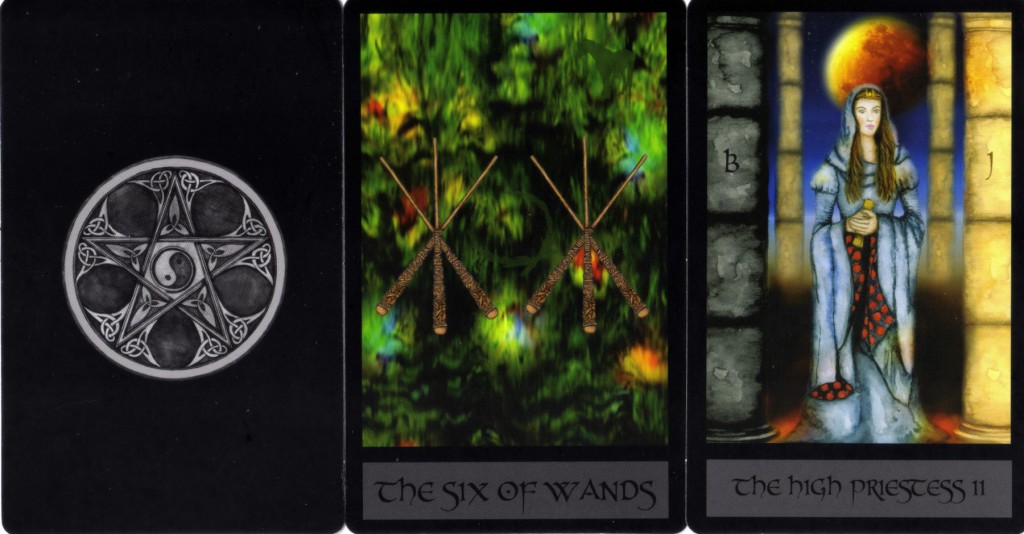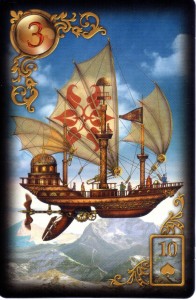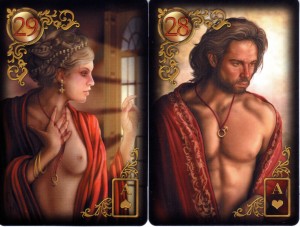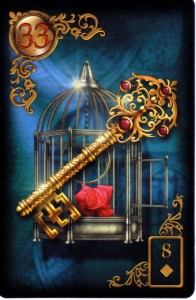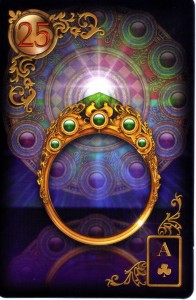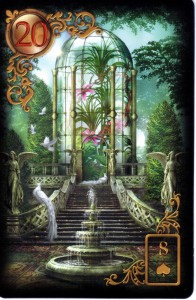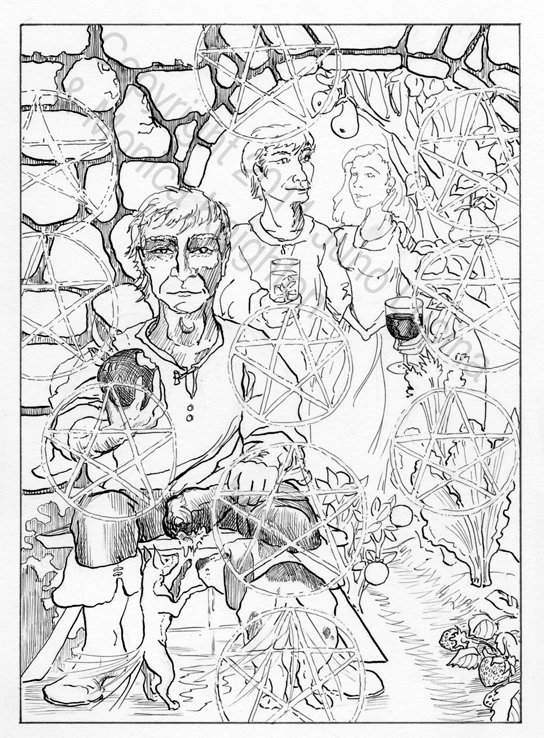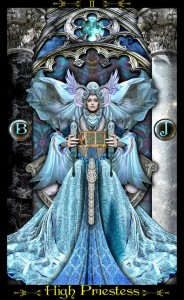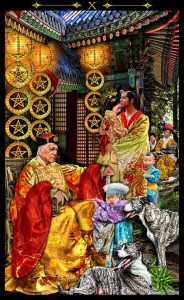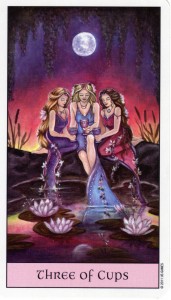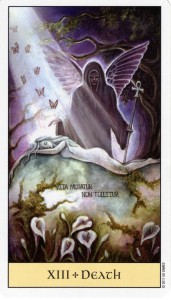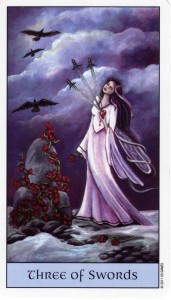The Wisdom Seeker’s Tarot
Posted by: The Tarosophist on: March 5, 2017
- In: Deck Reviews | Featured | Latest Decks
- Comments Off on The Wisdom Seeker’s Tarot
Originally published as The Truth Seeker’s Tarot in 2008 by Watkins, this deck has been re-issued as The Wisdom Seeker’s Tarot in 2017, after the authors death in 2010 following a short illness. David Fontana (1934 – 2010) was a widely-published author with over forty-five published works, including Psychology, Religion, and Spirituality (2003) and The Meditators Handbook (2002). He also published on dream symbolism, Zen, time management and earlier works such as Managing Classroom Behaviour (1986 & 1994).
He was foremost a psychologist, being Professor of Psychology at the University of Cardiff and visiting professor of two other universities – and one whom (in 1996) had helped create a transpersonal psychology section within the British Psychological Society. He was also a past-president of the Society for Psychical Research (SPR).
He saw both academic and mystical worlds as ultimately unified; in an interview, he spoke of Pythagoras, noting “‘Today he is only taught as a discoverer of a particular theorem, but Pythagoras also had a mystery school. It gave people access to deeper awareness through a variety of mediums, including sacred geometryâ€.
http://www.maggiehamilton.org/inconversation/david.htm
The artwork of the deck took over a year to produce and was created by “commissioned artist†Sylvie Daigneault, originally from Montreal, an artist, illustrator of children’s books (as was Pamela Colman Smith) and former dance group performer.
http://www.sylviedaigneault.com/
The first thing to say about the deck is that the text which accompanies it – both as the short seventy-eight-page booklet in the boxed set or the original (and much more detailed) The Essential Guide to the Tarot (Watkins, 2011) is that the correspondences for Wands and Swords are given as Air and Fire, respectively – the opposite to the common system derived from the Golden Dawn.
However – the artwork does not seem to reflect this version of the correspondence, and there is a piece of text in the Essential Guide where the elements and quarters are both listed after each other, in the order which would indicate the usual correspondences.
We have examined both works, and other works on symbolism by Fontana, and cannot find any indication that the switch was either deliberate or would indicate a confusion in the original text – which has been passed onto the new version. The example readings mainly use major arcana, and where the Wands or Swords are referenced, there is no indication of their elemental correspondence.
There is a note that the Six of Swords relates to the six-stage of the “rational and scientific fields for swordsâ€, which would usually lead us to equate Swords to Air through a correspondence of Air to thought, rationality and science.
Similarly, the artwork offers red as the predominant colour of the Wands, and yellow for Air, which are usually attributed to fire and air – the more common correspondence. If you did not have the text, we are sure most readers would not think the correspondence was meant to be anything other than the regular system.
This is a potential confusion which will remain unresolvable, as we discussed it with the publishers and they confirmed that the text in both books was from Fontana, and it is now impossible to clarify the original intention. It may be that the artist has design notes which would indicate the intention and the reasoning behind it, if it were deliberate.
It is a minor quibble (other than for an absolute beginner for whom it may be confusing) and brings us to consider the art of the deck and the utility of the accompanying booklet.
The Guidebook
We would certainly suggest picking up a second-hand copy of the more detailed Essential Guide to the Tarot (2011) as this provides more examples of the spreads and much more information on the symbology and variations of the cards to Waite-Smith, Thoth, Golden Dawn and Marseille decks. It is to be commended that the book provides a section on each variation, placing the design of the Major Arcana into a considered place within the tarot tradition – or traditions.
The artwork itself is instantly accessible and we would consider it ideal for beginners, particularly as it veers towards a Marseille-style décor on the Minor Arcana, proving a useful bridging deck between Marseille and Waite-Smith or other ‘scenic’ decks.
We would say it would make an ideal deck for younger beginners, given the style of illustration, however there are topless women (the four Princesses in particular) for which some adults may have consideration with regard to presenting them to younger readers.
Artwork & Symbolism
The deck is somewhat reminiscent of the Aquarian Tarot by David Palladini (US Games Systems, 1969) and the often maligned (wrongly, in our opinion) Tarot of the Witches (US Games Systems, 1991) designed by Fergus Hall, with whom the surrealistic elements of style are in common.
The Minor Arcana are styled as a Marseille deck but with scenic backgrounds and symbolism to convey the offered interpretation of the card. So, the Four of Cups shows a ship setting sail, carrying the four cups – which the booklet gives as “secrecy, depth, introversion …†which is not immediately obvious from the usual symbolic interpretation of a ship as voyaging, risk, trade and travel.
When we turn to the original book, we find the value of this card being more concisely “enterprise, depth†and the description stating clearly “the ships in this design symbolise that life is now reaching out to the wider world. This is a card of movement, at a steady, ordered pace, as signified by the stability of the number fourâ€. The book goes on with more detail and our recommendation is that anyone buying the deck ensures they get the original book to fully appreciate the design of the deck.
Another observation when we first looked through the deck was that the backgrounds were re-used in several cards. At first, we sought a pattern in this usage, as numerical patterns (especially pairs) are referenced in the book but when we enquired with the publisher they replied that the designs were chosen depending on the number and location of the cups, wands, swords, or pentacles on the card. So, we would not read too much into the choice of background in the minor arcana as a result.
The deck is perhaps more geared to self-development situations as certainly intended by the author – although oftentimes a deck can be perfectly used for “fortune telling†and predictive work even if it was designed as an intense Jungian analytical tool. Fontana states at the outset of the companion book:
“Tarot cards are best used to aid general self-development and inner growth rather than as a tool for fortune telling or for providing instruction about present or future actionsâ€.
Into the Structure of the Deck
The structure of the deck is worthy of some attention. As we commence with the Aces, Fontana develops the numerology of the deck when he states that they have “special significance as the number as both of the self, of our personal identity and of the unity that embraces all thingsâ€.
 The Aces are thus the “number of beginnings, of the first cause, of strength and of self-reliance, and of opening and awakeningâ€. He stresses that we are all individual, yet part of the whole “individuality and unity “are paradoxical, the one cannot exist without the other.
The Aces are thus the “number of beginnings, of the first cause, of strength and of self-reliance, and of opening and awakeningâ€. He stresses that we are all individual, yet part of the whole “individuality and unity “are paradoxical, the one cannot exist without the other.
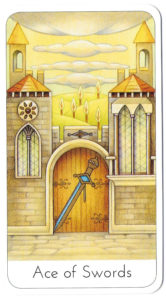 In the image of the Ace of Swords we are presented a gate-house and fixed upon the gate is a lone Sword. It crosses the door, the door through which “you can enter and exit at will.†The Aces psychologically and cosmically represent “the creative principle of the universe and thus denote absolute consciousnessâ€. We might even consider the Fool’s journey extended into the minor Arcana, where those who pass through these gates of the Aces commence the circular journey of existence. The view through the gate shows a tree-lined valley and beyond hangs a sky, pregnant with heavy lenticular cloud.
In the image of the Ace of Swords we are presented a gate-house and fixed upon the gate is a lone Sword. It crosses the door, the door through which “you can enter and exit at will.†The Aces psychologically and cosmically represent “the creative principle of the universe and thus denote absolute consciousnessâ€. We might even consider the Fool’s journey extended into the minor Arcana, where those who pass through these gates of the Aces commence the circular journey of existence. The view through the gate shows a tree-lined valley and beyond hangs a sky, pregnant with heavy lenticular cloud.
Working through the cards, the Two of Swords shares the same mystical iconography of the cloud and the sun along with the Four, Five and Ten of Swords. These cards pair up with heavy lenticular cloud symbolism, and create a profound pattern which alternates between uncertainty and faith. In the realm of Swords, we are constantly striving to rebalance our state between two edges of consciousness.
It struck us that the Five of Swords has a peculiar feel of mysticism to it, perhaps of the religious iconography such as illustrated by Wilfred Pippet, who illustrated two of the alternative Waite-Trinick tarot images. We see the sun, masked by clouds, streaming out in all directions and two doves meeting at either side of the sun. These symbolise a coming together, a reconciliation or union, but for there to be union there must first be a splitting asunder – an unrest or a state of limbo.
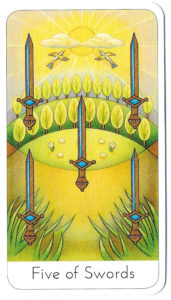 This state is found in the Five of Swords, where it is caught in the journey between Ace and Ten. This could be a traveller on a spiritual journey. Fontana wrote that the “Five of Swords is said to be a potentially unfortunate card, highlighting either possible danger or the need for protection.†It hints at the truth that it is when we are only half-way in any journey, be it a physical process that we are going through or a spiritual/emotional one it is often then we lose our way and fall into a chasm of indecision.
This state is found in the Five of Swords, where it is caught in the journey between Ace and Ten. This could be a traveller on a spiritual journey. Fontana wrote that the “Five of Swords is said to be a potentially unfortunate card, highlighting either possible danger or the need for protection.†It hints at the truth that it is when we are only half-way in any journey, be it a physical process that we are going through or a spiritual/emotional one it is often then we lose our way and fall into a chasm of indecision.
A Method of Using the Deck
We performed an initial reading with the cards using a tarosophy technique based on Kabbalah. We use this method to teach beginners and intermediate students a deep appreciation of the Tree of Life, without having to specifically learn Kabbalah – it is done through using their existing experience of tarot.
There are twenty-two variations of the method, one for each of the Major Arcana. Here we will use the Blasted Tower – which connects the two Sephiroth of Hod and Netzach on the Tree of Life.
We take the Blasted Tower out of the deck and place it on the table.
We consider a situation that is caught in a loop or cycle and one which we wish to change.
We shuffle the remaining deck and take out two cards, placing them (in this case) to the left and right of the Blasted Tower. You can take the top two cards, or one card from the top of the deck and the other card from the bottom, as feels best for you.
The card placed on the left shows our habitual thinking pattern about the situation.
The card on the right shows our ingrained emotional pattern.
Their relationship is through the Blasted Tower, and reading them together will suggest the change that we can best make now.
In this example reading we have the Two of Pentacles on the left and the Sun (XIX) to the right.
It signifies on one hand that “now that the one has become two and new beginnings are afoot, endings are also possible†(Essential Guide to the Tarot, Fontana, p. 191). This is in the realm of our habitual thinking. It seems that “a mysterious light floods the darkness†and that the balance that was sought has already started to change. Our thoughts have assumed that stability is possible when the situation is already split and change is underway.
On the other side of the Tower we see the Sun. The full text reads “each body is given to the other†in describing the integration and openness of this image. It shows that a certain journey is nearing its fulfilment and that the only remaining trial is of “surrender, not of effortâ€. The emotional side of this equation must be addressed by self-surrender to the authentic wholeness within oneself. As Fontana writes, “without this wholeness a person will remain alienated and a stranger even to themselves†(p. 126).
So, a powerful and profound reading, with deep significance. It also automatically installs an appreciation in the reader of the Sephiroth of Hod and Netzach on the Tree of Life and their relationship.
Cardstock: Glossy
Cardbacks: Orange Speckle pattern (reversible)
Borders: White, thin
Text: Modern font naming card in white banner at foot of each card.
Strength/Justice: VIII/XI
Court Naming: Princess, Prince, Queen, King
Note: In the first version of the deck (illustrating the original book), the Aces were called “The One of Swordsâ€, etc., but in this version, they are called “Acesâ€.
Summary
The Wisdom Seeker’s Tarot by David Fontana (pub. Watkins, 2017) is an interesting deck for beginners to intermediate readers who should decide about the correspondence issue of Swords and Wands. It is very accessible, friendly (considering topless female images) and the original guidebook is to be recommended in addition to the guidebook that accompanies the boxed set.
The Hobbit Tarot
Posted by: WendyStokes on: January 12, 2013
- In: Deck Reviews | Latest Decks
- Comments Off on The Hobbit Tarot
By Peter Pracownik and Terry Donaldson
Published by US Games Systems Inc.
78 card Tarot deck and booklet
ISBN: 978-1572816770
This Tarot deck provides a parallel between the amazing storyline of Oxford professor JRR Tolkein’s novel ‘The Hobbit’ and the experiences we have in our own life, and it seeks to provide caution and wisdom in order to help us achieve our aims. The booklet offers interpretations of each of the 78 cards and includes a 12-card ‘The Ring of Gollum’ spread, a 9-card ‘The Sword of Aragon’ spread and a 14-card ‘The Arkenstone’ spread, the latter unfolding as a spiral to be read in story-telling fashion, from the centre outwards.
UK-based Peter Pracownik is at the forefront of visionary genre artwork and has produced 78 inspired, creative artworks for this deck. He was also commissioned by US Games Systems Inc. to produce the artwork for the ‘Dragon Tarot’, the Wyvern Collectible card game, ‘The Lord of the Rings Tarot’, the ‘Imperial Dragon Oracle Deck’ and the ‘Woodland Wisdom Oracle Cards’. He has held successful exhibitions in Hollywood and has made appearances on TV in the UK and US.
London based Terry Donaldson is a professional Tarot reader, guide and healer, and the author of several books on Tarot, magic and folklore. He travels extensively and has studied in Greece, Iran and India. He previously collaborated with the artist, Peter Pracownik on ‘The Dragon Tarot’ and ‘The Lord of the Rings Tarot’.
The card backs are imperceptibly irreversible and provide a Kabbalistic-style geometric web design with a golden ring to represent each of the sephiroth. I was pleased to see this glyph, as we are reminded that within the chaos and violence of this story, morality and spiritual values play a vital part. I found that the deck and the storyline have a staunch masculinity, similar to the myths of the Anglo Saxons which originally inspired the novelist.
I have chosen to describe two cards as samples:
The Four of Cups features Gandalf (also chosen for the front of the packet) shown with his tall conical hat and his long grey beard. He is sitting and filling his pipe under a tree by a pool in the gloaming. He is reflecting on his next move. Throughout the story, Gandalf disappears but returns when he is most needed by the Companions.
Divinatory Meaning: Reach out for new friendships, withdrawing from others, feelings of dejection. This card tells you that things are being taken too personally and apathy is taking place. You are becoming stuck, unable to see new opportunities that are presenting themselves. It is time to take down defences and have greater trust in the goodness of others.
Reversed, it can show that you might need to spend more time in meditation or personal reflection, separating yourself from others in order to regain your centre of gravity.
The Three of Coins shows three trolls, one holding a large sack. Poisonous toadstools grow in the foreground. The monsters have captured the Companions and are preparing to eat them. But Bilbo thinks quickly and plays for time, and this aids their eventual escape.
Divinatory Meaning: Learning new skills and abilities, professional growth, establishing oneself, and becoming more aware of one’s abilities. The card also pertains to team activities and good organisation. It is not possible to create anything without support and co-operation. The presence of the card in a reading portrays the discovery of a new passion.
Reversed, it indicates an inability to see the wood for the trees, or being overly attentive to details or rules, or too critical, absorbed, or failing to read the right signals. It can also question present knowledge and whether it is up to date.
You are invited to respond and provide feedback about this deck on the website. http://www.peterpracownik.com/
Reviewer: Wendy Stokes www.wendystokes.co.uk
The Salvador Dali Tarot Book
Posted by: WendyStokes on: January 9, 2013
Artwork by Salvadore Dali
Text (192 pages) written by Johannes Fiebig
ISBN: 978-3898756204
The Salvador Dali Tarot Book is a prestigious Jubilee edition paperback of quality full colour reproductions of the 78 cards in the Dali Universal Tarot deck. It contains detailed interpretations for each card, information about layout and method of choosing and reading, the sources and inspiration of the images and further information about Dali and his work with the Tarot.
The German author, Johannes Fiebig, is a Tarot expert of international renown. Of his previous books, several were co-written with his partner, Evelin Burger, such as ‘Tarot Basics’ and ‘Complete Book of Tarot Spreads, ‘Crowley Tarot’ and ‘Waite Tarot’, amongst others. The text offers an easily readable yet deep understanding of the tarot combined with a no-nonsense approach which is both refreshing and valuable to the reader. The Introduction is by Dr. Annette Koger-Kaufman, the Director of the German Playing Cards Museum who states: “It is my sincere hope that readers will succeed in opening this window by studying the profound interpretation of the unique art of Salvador Dali, one of the most popular artists of the 20th century.â€
This deck was created by Dali in the mid 1970s when he was 70 years of age and he was the first well-known artist to produce a set of Tarot cards. Each image depicts a mysterious, irrational and dream-like scene with enigmatic emblems, such as butterflies, crutches and silhouettes. Some images have been inspired by famous places and by distinguished European artworks throughout history. Several are original works by Dali. The 22 Major Arcana provide unorthodox correspondence for Hebrew letters and astrological signs. Each Major Arcanum card is titled in both English and Spanish, for example ‘Los Enamorados’ for the Lovers and ‘El Loco’ for the Fool. 0 The Fool is positioned at the end of the Major Arcana and the Court Cards describe Queen, King, Knight and Page. The suits are represented by Wands, Cups, Swords and Coins as Pentacles.
The author states: “Although the pictures of the Dali Tarot go way beyond the usual motifs and imagery of other Tarot versions, it is plain to see that Dali continues a 500 year old Tarot tradition. All his pictures preserve as well as recreate the traditional themes.â€
We are instructed to think of a question, shuffle the deck, select and allow intuition to guide us in choosing a card. I have chosen two cards: Card number 1, The Magician and card number 9, The Hermit.
The Magician (El Mago) has been chosen to illustrate the deck on the front cover of the book. Described as the card of ‘Personal Magic’, the energy is real magic which is not limited to trickery, sleight of hand, hocus-pocus or stage illusions. With this magic, we transcend the normal and become one with ourselves, with God and the world. It shows Dali himself in the central position as the Magus; in front of him are many of the tools of his trade and some of his most well-known works, such as the melting clock which represents elasticity and uniqueness of our own personal view and experience of time. The scroll symbolises the making of plans and the designing of our own life path. The scene is reminiscent of Leonardo’s ‘The Last Supper’ with Dali in the position of Jesus with the bread and wine on the table, representing our participation in the divine act of creation. The arches are those of Sainte Chappelle, Paris, the pillars of which denote aspects of the personality which need to complement each other and unite to serve a higher purpose. The card interpretation states: We see Dali, but we realise that this card is really about you and me and our own individual talents and qualities. Flames lick around the central character, these are the fires of the creation and transmutation and the life-force which is within us. We are instructed by this card to make the most of our imagination, creativity and communication skills and to do something extraordinary and unique.
The Hermit (El Ermitano) is described as ‘Healing’ and we are reminded of the New Testament story of the wise virgins who keep the wick of their lanterns cut and ready. The card directs us to re-evaluate and re-organise our life. The image is of Luca Pacoli, a lecturer of genius at the University of Perugia, Italy, born 1445. He invented an advanced book-keeping system. He also wrote a book about the entire knowledge of mathematics which was illustrated by Leonardo Da Vinci to whom he taught the art of perspective and proportionality. He inspired Leonardo to paint The Last Supper, a fresco at the Dominican Monastery of Santa della Grazie. The Hermit appears to float above a black cloud. For me this cloud represents the miasma of the common-place. He wears the brown robe of the Franciscan and holds in one hand a stick as though he is writing in the clouds or parting them and in the other hand he holds a lantern. I am reminded of Holman Hunt’s ‘The Light of the World’ in St Paul’s Cathedral, London. Within the light of the Hermit’s lantern, we see an embryo which contains the spark of human life and the potential for a lightworker to be born and commit to becoming a leading light of truth, peace and caring justice. Above the head of the figure, we see jewels, some in the shape of an egg, which reminds us of the origin and miracle of life. The card states: Your light expands by resolving your contradictions. You will not get close to the magnificent power of the Hermit if you are not assuming responsibility for your life. The Hermit solves problems at the appropriate time and goes about his life without sweeping anything under the carpet or leaving anybody in the dark. The card is about using your own light to heal and sanctify the world and help to recreate a ‘virgin’ earth.†The card sometimes directs us to rest and withdrawal but also to commitment, effort and responsibility. We are instructed to ‘pay our debts’ – in a material as well as moral sense, to increase our own wellbeing and wealth (whatever that might mean to us) and to spread our good fortune to others.
Reviewer: Wendy Stokes www.wendystokes.co.uk
A reprint of the Dali Universal Tarot is due for release, with Johannes Fiebig as the author, sometime in 2013.
The Enchanted Tarot
Posted by: WendyStokes on: January 4, 2013
- In: Deck Reviews | Golden Oldies
- Comments Off on The Enchanted Tarot
The Enchanted Tarot
By Amy Zerner and Monte Farber
Box containing 78 cards, 192 page fully illustrated guidebook
Published by Connections Book Publishing
Through the Enchanted Tarot we are invited to enter ‘a realm of myth and magic’ and this quality deck certainly delivers both by providing a depth of symbolism within traditional and other tales. I can vouch that this deck will come up to expectations for Tarot and art enthusiasts. Its strengths lie in its profound wisdom set within the card concepts, and also the beauty and majesty of its detailed illustrations (which can be viewed under a magnifying glass for added enjoyment.)
In the companion book three powerful aspects of understanding are provided for each card. These are under headings of ‘The Dream’, ‘The Awakening’ and ‘The Enchantment’. The Dream supplies detailed explanation of each card’s concept, The Awakening provides personal guidance and The Enchantment assists development to deal with the issue which might arise as a result of the choosing of the card.
Information is given about the art and nature of divination (and these cards include the possibility of foretelling the future), how to prepare for the reading and how to interpret the cards using examples provided. Various spreads are explained, including one card and three card readings and more detailed spreads for 11 card readings.
I have chosen for my review The Three Level Spread. I am to visualise the question and ask for an answer on three levels and am instructed to shuffle seven times and cut, then pick three cards and lay them face-down from left to right, turning them over one at a time, the first to show the foundation of the matter, the next, a message describing the conditions or circumstances that have contributed to where I am now. The third and final card is to carry a message about the outcome. The first card therefore represents the Past, the middle card, the Present and the last card, the Future. If the outcome is not a desired one, draw one more card to obtain a future perspective which will be more advantageous. The three card spread can also be used to give information about the mind, body and spirit.
My first card is the Three of Hearts (traditionally Cups) and is titled ‘Celebration’. The Dream depicts three dancers framed by a heart shape dancing in honour of love as they invite others to join them to eat and drink and make merry. They represent Faith, Hope and Charity, and offer sympathy for those unable to experience pleasure and sensitivity. Flowers and ripe grapes are crushed beneath their feet and friendship and fulfilment of love’s promise to heal is given to those who partake of the energy of this card. For The Awakening, I am instructed to celebrate joy, creativity and happiness and to have gratitude and share my good fortune with supportive friends. Work might suffer a little but it is an important time to grow emotionally. The Enchantment instructs me to gather friends together for afternoon tea and not to allow any inharmonious chatter to take place. Lift cups and make this pledge: ‘Merry meet and merry part and merry meet again, the dance of life’s more pleasing since I have you for a friend’.
My second card is The Chariot. The Dream and the Warrior Maiden carry the spoils of war. She is Brunhilde and she triumphantly wins the race on her reindeer steed against formidable opposition. She carries her shield to symbolise the aggression which brought her victory. She has a good physique and a stern resolve, bravado and self-assurance, and she has suppressed all emotion but this will not serve her in all situations. Golden unicorns on the horizon represent her aspirations and these are where she is heading. The Awakening tells us that in order to triumph, we must take the reins of control and enlist other assistance in our quest. Right now, there is no room for emotion, just single-minded concentration on the goal. But as we grow, we need to remember to remove the frightening mask so we can be our true selves. The Enchantment offers us a space to close our eyes, see a strong, white light surrounding us, making us radiant with energy and health and strengthened within and without. We are to daily visualise the accomplishment of our goal and accept adulation. Power and determination lead us to victory!
My third card is the Four of Swords, titled ‘Seclusion’, and depicts a Buddha sitting in meditation. Within The Dream is a place of stability and retreat from strife and anxiety and it is surrounded by a pyramid which creates healing. Clouds of confusion and the everyday world are parting and a time for recharging and grounding has arrived. The previous card of the Three of Swords is one of self-pity and attachment, and it is important to move on now, to detachment and protection. Cosmic forces are flowing to give insight when quiet retreat is achieved. The Awakening invites us to withdraw to a sanctuary, look inward, reflect, examine ourselves, accept, understand, receive guidance, be healed and renewed. The Enchantment is advice to sit still, spine upright, breathe deeply, in through the nose and out through the mouth until you are calm and focused.
Amy Zerner’s art-work illustrates the archetypal stories and the healing energies of these cards. They are a magnificent collage of beautiful paintings and exotic fabric designs. Her life partner, Monte Farber, has provided the card concepts and provides a wealth of interesting stories to touch hearts and minds with spiritual consciousness. This very successful couple have sold two million books which have been translated into fourteen languages. Their site: ‘The Enchanted World of Amy Zerner and Monte Farber’ provides much enrichment and enlightenment for all spiritual seekers. Delight and excitement await you!
Reviewer Wendy Stokes www.wendystokes.co.uk
The Joan Charles Tarot
Posted by: TheReviewer on: December 29, 2012
- In: Deck Reviews | Featured | Latest Decks
- 1 Comment
Although it is called the Joan Charles Tarot, this beautiful deck is actually painted by art student Berangere Toulet. She was chosen from a submission of four artists’ work to give an artistic voice to the designs and Tarot knowledge of Joan Charles, author, psychic and columnist for the Scottish Sun newspaper. The Joan Charles Tarot is a traditional deck with 78 cards, the Major Arcana retaining their usual numbering and titles, and the suit names and Court Cards following the Rider Waite tradition. The cards are larger than normal Tarot cards, on the plus side allowing the images to be more easily seen, on the downside not great for those of us with tiny hands. They are printed on high gloss card stock, with black borders and the titles of each card in a silver box at the bottom of each card. This size of the cards, coupled with the bold colours, make this a striking deck to use.
Some truly beautiful artwork can be found in this deck, with bold swathes and splashes of colour, elegant starscapes, intense characters and easy to read scenes. There are some really nice touches in the Major Arcana images that strike me as brilliant: the inner folds of the High Priestess’ robe showing us rich, red pomegranate seeds; the terrifying ferocity of the lion in Strength; the ancient carvings that are illuminated by the Hermit’s lamp, as if he is wandering beneath long-forgotten catacombs; the way that the traditional zodiacal creatures of the World card are entwined together in a living tree, the branches of which support the globe of planet Earth, in a symbiotic dance of life. Whilst the artwork in the Major Arcana is deeply traditional, it presents that tradition with a subtle twist and innovation.
Those who like fully scenic Minor Arcana will be disappointed with the Joan Charles Tarot. Each of the Minors is illustrated with the backdrop appropriate for its suit, with the appropriate number of suit symbols on it. The Three of Cups is just three cups stacked together, for instance. In places there is possibly a suggestion that there was an attempt to convey meaning in the pattern the symbols were arranged in, such as the Nine of Cups, which has its cups arranged in what looks like a heart, but this does not seem to be consistent throughout the cards. However, there is a concession to the card meanings on the Minors, if you look very (very, very) closely (and make sure you’ve got your reading glasses on.) On each card, somewhere, are one or two very simple, single-coloured, almost silhouette-like images that relate to the card meaning. You have to hunt for them in some cards, and certainly the colouring in certain suits makes it difficult to find them in places (the Wands suit was particularly troublesome for me!), but they are at least an original idea that I’ve not seen elsewhere in other Tarot decks. Many of these symbols are directly related to traditional Tarot symbolism, such as the dove (accompanied by a rose) upon the Ace of Cups, which links to the image of the descending dove bearing a communion wafer in the Rider Waite image. Others are more abstract but still convey meaning, such as the key upon the Four of Pentacles (actually found in the centre of the arrangement of four pentacles, as if boxed in), the winding road on the Eight of Wands, and the waterfall on the Five of Cups. Some of these symbols are very easy to read, and would be easily understood by even the most literal of people: the heart split in two on the Three of Swords, the shackled wrists on the Nine of Swords, the fireworks and clinking champagne glasses on the Three of Cups.
Each suit has a different colour scheme and a hint of a season: the Swords are set to a backdrop of wintery ice blues and white, the Wands are full of the lush, vibrant green of Spring, the Cups are the beautiful contrast of red poppy fields with blue sky and green trees suggestive of Summer and the Pentacles are the browns and greens of Autumn leaves. Similarly, the Court Cards share their suit’s colours, with the Court of Swords wearing purple cloaks or dresses, the Court of Cups is varying shades of blue, the Court of Pentacles in greens and browns, and the Court of Wands in gold. Although at first I was disappointed with the Court Cards because they lack symbolism, I realized that their stances, postures and interaction with the suit symbol was actually quite meaningful and easy to read. For instance, the Queen of Cups appears to be dreaming or daydreaming as she stares at her cup, the Knight of Swords kneels in the snow with his sword point downwards to provide balance, as if he is searching for tracks, the Queen of Wands sits open-armed upon her throne and stares directly at us, and the Princess of Pentacles holds her pentacle in both her hands and studies it carefully. A beginner still might find it difficult to remember card meanings with these Court Cards, but once familiar with them, the figures in these cards could become very real personalities.
The card backs are bold and striking, being completely black apart from a silver-grey version of the Celtic-style Pentacle design used throughout that suit. A quick quick suggestion for those buying the Joan Charles Tarot: you will need to get a new deck box or bag to store it in, since the deck is so tightly packed into its box that after one or two shufflings of it, I could not get it back in without bending a card with the force of my attempt!
This is a deck that I can see becoming very popular with beginners, and certainly its association with Joan Charles and the Scottish Sun newspaper will help push Tarot further into the mainstream, bringing new enthusiasts to the art. However, it does not come with any companion book, giving us only two cards with a few keywords for the Major Arcana, meaning that for those who start Tarot with this deck, other sources of information will have to be used. The Joan Charles Tarot is attractive and aesthetically pleasing, and more experienced readers will enjoy seeing the traditional Tarot archetypes presented in this striking and dynamic manner. However, I feel that the deck is let down by the Minor Arcana, since the Majors are so stunning and clever, whereas the Minors feel like they were rushed, tacked onto the end of the project, and slightly lazy. I’d love to see more of Toulet’s art, particularly pertaining to Tarot and the esoteric, and hope that in coming years she has more to offer us.
The Joan Charles Tarot by Joan Charles and Berangere Toulet
ISBN 978-0-9574634-00
Published by Joan Charles, 2012
Creator’s website here.
The Gilded Reverie Lenormand
Posted by: TheReviewer on: December 28, 2012
- In: Deck Reviews | Featured | Latest Decks
- 3 Comments
I’ve tried very hard to get into the Lenormand craze that has taken over the Tarot world in 2012 (and is set to do so into 2013), but I found it very difficult. For starters, I’m an aesthetic girl: I like things that look exceptionally pretty, I enjoy sumptuous images filled with detail and bold colours. Most Lenormand decks just don’t excite me. But then along came the Gilded Reverie Lenormand by Ciro Marchetti, and I’m a convert. These luxurious, deep, colourful and clever images, printed on cards larger than the usual Lenormand size, draw the reader into their landscapes and offer them what are undoubtedly the best edition of traditional Lenormand cards to date.
The Gilded Reverie (now sold out in its second printing, with a third printing hopefully being released any day now) comes packaged in a beautiful black box (the kind that you lift the lid off so that it is in two parts) that has a leather look, with the title card printed in the red, black and gold design of the Gilded Reverie on the front. Within this, the cards are stored in a black leatherette drawstring bag, and this bag has an inscription from Ciro himself in silver: “Through your voice these cards can speak. CM.†Well, it was like opening up a piece of an earth shattering mystery, seeing this enigmatic inscription from the maker of these mystical cards…
This feeling just grew as I opened up the bag and carefully, almost reverently, thumbed through the cards. The first card to greet us is the signed title card, which makes this deck a great addition to any collector’s horde. The entire deck is printed on thick low-gloss, high-matte card stock, the only noticeable gloss being the beautiful ornate swirling (“gildedâ€) corner designs in the top left and bottom right of each card, the card number (found in the top left corner) and the playing card correspondence (found in the bottom right corner). The Gilded Reverie has the traditional 36 cards of the Lenormand that we know and love today, but comes with some additional (optional extra cards). Ciro has very kindly supplied us with two different Birds (12) cards, one showing a daytime scene with four bullfinches surrounding a birdhouse, the other showing a nighttime scene with two barn owls together beneath the moon. A reader could either choose to use only one of these, keeping the other for collectible purposes, or could keep both in the deck to signify subtle differences in that card’s meaning. Also optional are the two extra Gentleman (28) and Lady (29) cards, though it is clear that no single design out of the two was intended for the deck by the artist, but instead offered for us to choose from. These cards are designed so that each Gentleman and Lady forms a matching pair (traditional for Lenormand decks), but in
the Gilded Reverie one pair is more romantic, each holding a single rose and looking dreamily at the other, whilst the other pair is more sexual, each almost bare-breasted, sporting tousled bed hair and intense expressions. It is suggested that a reader could deliberately use two Gentleman cards or two Lady cards in a reading for a gay or lesbian client; as an extension of this one could conceivably use all four, or three of them, for a poly-amorous relationship, or utilize three of the correct gender for a situation in which there is a choice to be made between lovers… These optional cards are a great addition to the Lenormand, bringing it more into the 21st century. On a personal note, I am very pleased with the addition here, because all of the Gentleman and Lady cards are beautiful, and I’m sure I’m not the only person who will stop at the more sexual Gentleman card and have a minor heart palpitation.
We are also given four extra cards (numbered 37-40) to use if we wish: Time, Bridge, Dice and Mask. Although there is no companion book that arrives with the deck, a .pdf version (in full colour, 59 pages) is available for free to download from Ciro’s website. This companion book gives information on the extra cards, as well as telling us that it is only a series of chance events and geographical/chronological bias that made certain cards a feature of the final Lenormand template used today instead of others. This book, put together using key points provided by Rana George, and additional summaries by Tali Goodwin of Tarot Professionals, with information from Ciro as well, is highly recommended for use alongside the deck, since it is full of Lenormand history, how it developed, and interesting facts about the tradition. It also gives in depth meanings for each card, including what they might mean in a few combinations together with other cards in a reading.
I was pleased that the Gilded Reverie shows the playing card association on each card, since I find this to be a useful correspondence in the tradition; however, those who like the appearance of the short poems (such as in the popular Mlle. Lenormand Fortune Telling Cards by US Games) will be disappointed. However, including these would have done a great injustice to the card images, which are opulent, detailed, striking and, in places, very Steampunk! (I approve of Steampunk greatly. Check out Ship -3 – and Book – 26 – for some examples of the cogs and machinery working its way gently into the Gilded Reverie.) Anybody remotely familiar with Ciro’s work will instantly recognize this as his, bearing his distinctive style that is a mixture of naturalistic, cosmic, fantastical and mechanical, all presented in the jewelled, bold colours of a carnival. There are nods in the Gilded Reverie to other occult teachings, such as the appearance of the Kabbalistic Tree of Life on the Tree (5), and the zodiac signs on the Stars (16) and Book (26). Those in the know might also be pleased to find the mystical Rose and Key as companions on the Key (33). Other intriguing and well-thought out details include the actual content on the Letter (27), which is written in French (mine is poor, and I gave up trying to translate, but I’m sure it is something very interesting.) As an added bonus game (I used to enjoy doing this as a child), Ciro’s initials can be found in every card, hidden somewhere. I spent a good while searching each image for them, but then I am easily entertained.
To make this deck even more collectible and unique, Ciro comments in the companion book that several of the cards have different colour schemes for their images, and that during assembly the different versions of each card were randomly assigned to each deck. He says, “The chances of anyone else having an identical combination of colored cards as you are more than 1 in 8000.†(pp. 14) For instance, my House (4) has a purple roof, but I have also seen one with a red roof; my Ring (25) is set with emeralds, whereas the one featured in the companion book is set with rubies. This is a clever idea, and one I have not seen done before in any deck – one of the beauties of self-publishing!
The only downside of the Gilded Reverie is that due to the card stock, the deck arrives slightly warped (the cards all bend upwards at the top and bottom.) This can, however, be solved with heavy books, and it is just one of those things that happens with certain card stock. I also noted that the images seemed darker in the deck than in the companion book, though I wouldn’t have had a complaint about it until I had compared with the book. Finally, I would be concerned about the hardiness of this card stock against frequent use. Black borders might become scuffed and reveal white, and this card stock, not being glossy and protected as much, might suffer from the everyday dirt of hands and shuffling. However, I also have a solution for this: buy two copies of this marvelous Lenormand deck – one to keep in pristine, collectible condition, and the other to read with!
And there’s the rub: if you get the Gilded Reverie Lenormand, you won’t want to put it on a shelf in your collection; you’ll want to read with it, thumb through it, salivate over the images, show others, and maybe put a certain Gentleman card in a picture frame on your bedside table… But at the same time, it’s not the kind of deck you want to throw in your bag and carry around everywhere with you. This is a deck you keep reserved for special readings, for readings for yourself over a glass of wine while listening to your favourite music, a deck to read accompanied by your favourite meal. This is a deck that you should allow to seduce you into the Lenormand tradition, to wine and dine you with its intricate images and carefree beauty, and it is a deck that will take you by the hand and place you, alongside countless other Tarot and oracle enthusiasts, in that long line of cartomancers and oracle givers, starting – as legend would have it – with that famous French card reader Mlle. Lenormand.
Gilded Reverie Lenormand by Ciro Marchetti
Self-published by Ciro Marchetti, 2012
Available from artist’s website here.
Ready for Pre-Order: The Healing Tarot!
Posted by: TheReviewer on: December 19, 2012
- In: Announcements
- Comments Off on Ready for Pre-Order: The Healing Tarot!
Back in March we took a sneak peek at the forthcoming Healing Tarot: 78 Ways to Wellness by Juno Lucina and Monica Knighton. This beautiful black and white 78-card deck is being released by Schiffer Books in April, 2013, and is now available for pre-order. This dynamic duo of deck creators has a vast amount of experience behind them, including the creation of the Tarot of the Dead, Stolen Child Tarot (Monica Knighton), The Kingdom Within Tarot, and the Alchemy of Tarot (Juno Lucina). It is clear from the images (you can see them on the Healing Tarot website) that even though there is no colour in this deck, it is filled with vibrancy, passion, life and character. This deck looks set to not only provide an excellent tool for accessing one’s inner self and processes, but also to show traditional Tarot concepts with a new and original take on the symbols and images.
You can pre-order the Healing Tarot through the publisher, Schiffer Books.
Sneak Peek: The Tarot Illuminati
Posted by: TheReviewer on: December 17, 2012
- In: Announcements | Sneak Peaks
- Comments Off on Sneak Peek: The Tarot Illuminati
Here’s a deck that’s been taking the Tarot world by storm: the Tarot Illuminati by Erik C. Dunne. The great news is that this deck is now in production, and is due for release on May 8th, 2013, by Lo Scarabeo. It will come in a 78-card deck and book set, with 160-page companion book by Kim Huggens.
You can pre-order the Tarot Illuminati at Amazon, or via the Lo Scarabeo and Llewellyn websites. There will also be an extended companion workbook to the Tarot Illuminati released by Llewellyn in 2013. You can check out more of the artwork at the Tarot Illuminati Facebook page.
II The High Priestess
Here we have the passive feminine (as opposed to the Empress’ active feminine), complete receptive and silent. The High Priestess forms a complement with the Hierophant, she representing inner wisdom, and he representing received wisdom. Together they present to us two equally useful modes of learning and understanding. It is this card that has become the “cover girl” for the Tarot Illuminati, and which gives a wonderful insight into the style of this beautiful deck.
The Princess of Pentacles
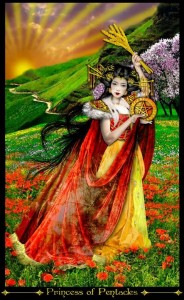 Earth, being the lowest and most manifest of the four elements, may at times be seen as less interesting or disconnected from the spiritual plane, and thus the Princess of Pentacles may also seem like the lowest manifestation of energy in the Tarot. However, Earth is fertile and fruitful, it provides us with all of our sustenance, a foundation for our lives, and it is in the plane of Earth that we grow. Thus, although the Princess of Pentacles is, indeed, the lowest of the cards of the Tarot, she is also the most fertile. All the energy of manifestation has fallen into this card, and now it lies within the belly of the Princess, who will bring it to birth. Essentially, in this card we find rebirth for the Tarot itself, as we can imagine that each card is contained within the Princess’ womb, just as all the seeds of life are contained within the earth.
Earth, being the lowest and most manifest of the four elements, may at times be seen as less interesting or disconnected from the spiritual plane, and thus the Princess of Pentacles may also seem like the lowest manifestation of energy in the Tarot. However, Earth is fertile and fruitful, it provides us with all of our sustenance, a foundation for our lives, and it is in the plane of Earth that we grow. Thus, although the Princess of Pentacles is, indeed, the lowest of the cards of the Tarot, she is also the most fertile. All the energy of manifestation has fallen into this card, and now it lies within the belly of the Princess, who will bring it to birth. Essentially, in this card we find rebirth for the Tarot itself, as we can imagine that each card is contained within the Princess’ womb, just as all the seeds of life are contained within the earth.
Ten of Pentacles
“I am very old, and the sounds of my bones cracking when I move is the sound of the earth shifting; the sound of my rasping breath is the sound of the wind in the mountains and my fragile frame bends like the weeping willow over a river. But my experience is like the fountain of youth and my wisdom the elixir of immortality, for I offer it to those that have come after me, and I will live on in their joys and achievements, their comforts and their challenges. I have worked all the days of my life and seen the wide world, and I have tales to tell that are truly wondrous. I may not be blessed with many more days, but what I have I will give whole-heartedly to my family, so they may know from whence they came, and what awaits them in life. May the best days of my life be their worst, and may they live to see as many seasons turn as I. But let them never forget their ancestors, let them always know that those who came before are smiling upon them… not because their spirits linger (we deserve our rest after our long travels!) but because they leave a legacy upon earth that blesses their descendants. I did not always know the comfort in which I now rest, nor the luxury and wealth in which we now thrive; I began with little more than the ability to work hard and work well. It was the sweat of my brow and my tenacity of will, the hours I put in and the effort I expended, that raised me up in the world and in spirit and wisdom. My family now want for nothing, yet I wish for them to know the value of work, and this I will teach them before I am gone. Most importantly, I will show them what it means to be family, and what they will do for each other when called upon. My final legacy to my descendants shall be to teach them how to love one another unconditionally, how to respect one another and their elders, how to work well, celebrate joyously and frequently, and how to pick each other up when they fall. This they too will pass on to their grandchildren when the cracking of their bones is the sound of the shifting earth and the rasping of their breath is the sound of the wind in the mountains, and my days shall continue unto the end of my line.†[Excerpt from the companion book, by Kim Huggens]
About the artist
Twenty Five years ago, Erik discovered the art of Tarot quite by chance and thus began a journey that would inevitably result in the creation of his own deck, the Tarot Illuminati. Although he presently resides in the United States, he has traveled extensively Abroad and actually lived for some years in the Middle East. He has retraced the footsteps of legendary kings and queens, ridden camels across the dunes of Persia and galloped heavy steeds across fields of gold. His diverse life experiences are matched only by his opulent imagination, both of which are apparent in his artful creation of a cast of rich characters and fantastical realms. Although a classically trained artist, his medium of choice is digital, where he has allowed his passion for costume design and his roots in the theater to lend their resounding voice to each and every card of the Tarot Illuminati. Erik is presently a freelance graphic artist working on diverse commissioned projects, and has recently begun work on a much anticipated sister deck to the Illuminati, loosely based on the translations of ancient Sumerian texts.
The AlphaBet for Lovers
Posted by: TheReviewer on: December 17, 2012
- In: Deck Reviews | Featured
- 1 Comment
The AlphaBet for Lovers, by Orna Ben-Shosan
http://kabbalahinsights.com
There are a lot of oracle decks out there for the diviner, using different themes and concepts to tap into your inner self and your future. There’s oracle decks filled with angels, fairies, mermaids, unicorns, Goddesses, Gods, Hindu mandalas, mantras, saints, crystals, dolphins, and more… yet there aren’t many that utilize the ancient Hebrew system of mysticism, the Kabbalah, to gain and give wisdom. The ones that are currently available are quite serious, and expect the reader to have an intimate and profound understanding of the Kabbalah to accompany the usage of the deck.
 However, the AlphaBet for Lovers is a cute, fun, simple and approachable deck using the wisdom of the Kabbalah to expound on the reader’s love life and social relationships. It even has expressive artwork on the cards to make it pleasing to the eye and intuitively easier to read. This allows even those with no knowledge of the Kabbalah to use this deck straight out of the box – which is what many people look for in an oracle deck. This deck consists of 72 heart-shaped cards, each with an image on one side, and on the other side showing the card’s number, the Hebrew letter and its name, a single sentence about the card’s meaning, and that meaning written in Hebrew. But aren’t there only 22 letters in the Hebrew alphabet? Indeed there are – but this deck offers us three cards for each of the 22 letters, highlighting different aspects of the meanings of those letters, as well as extra cards (in Hebrew, some letters will be written differently depending on where they are in the word, e.g. “final†Kaf, or “final†Peh (indicating that those letters are different if they appear at the end of a word. There is also one final extra card called, simply, “The Crazy Heartâ€.
However, the AlphaBet for Lovers is a cute, fun, simple and approachable deck using the wisdom of the Kabbalah to expound on the reader’s love life and social relationships. It even has expressive artwork on the cards to make it pleasing to the eye and intuitively easier to read. This allows even those with no knowledge of the Kabbalah to use this deck straight out of the box – which is what many people look for in an oracle deck. This deck consists of 72 heart-shaped cards, each with an image on one side, and on the other side showing the card’s number, the Hebrew letter and its name, a single sentence about the card’s meaning, and that meaning written in Hebrew. But aren’t there only 22 letters in the Hebrew alphabet? Indeed there are – but this deck offers us three cards for each of the 22 letters, highlighting different aspects of the meanings of those letters, as well as extra cards (in Hebrew, some letters will be written differently depending on where they are in the word, e.g. “final†Kaf, or “final†Peh (indicating that those letters are different if they appear at the end of a word. There is also one final extra card called, simply, “The Crazy Heartâ€.
The artwork on the cards can be described as slightly surrealist, though each can be interpreted on its own with a little thought. Each shows a scene of a couple interacting in some way, though often in a strange setting or surrounded by surreal circumstances. In one, “Drowning in your own emotions†(Mem, card 40), we see a man and woman, fully clothed, swimming in the waves of an ocean. The man tries to pour water from a jug out into the sea – presumably to remove some of the water he is surrounded by – while the woman swims, unaware. In another, “Opening, healing and salvation†(Peh, card 52) we see a twist on Botticelli’s famous “Birth of Venusâ€, with a partially naked man rising from water, blindfolded, his hands covering his heart and genitals, while a fully clothed woman in red and white brings red clothing to cover him. 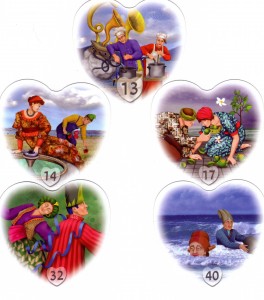
The cards could be read simply with the words written on them and the images; however, the accompanying 104 page book is thorough and in-depth I offering interpretation of the cards. As well as explaining a brief history of the Kabbalah, offers some spreads, gives advice on how to approach timing questions, yes/no questions, and on reading for others, and offers a threefold interpretation of each card: “For singlesâ€, “Personality†and “Advice.†Each Hebrew letter is discussed briefly in its own right also, which highlights some of the themes that run through the three cards associated with it. Some of these themes are easier to see than others. For instance, since “Mem†means “Waterâ€, it is easy to see the connection of all three of its cards – water and the emotions. However, in places a non-Kabbalist might find it difficult to see these threads.
What impressed me about this oracle deck was the author’s obvious wisdom in this area of life. The “advice†section of each card interpretation is filled with useful approaches to a healthy relationship which would help a lot of people if they read it. This makes the AlphaBet for Lovers a useful tool not just to find out about love in the future, but to work on an existing relationship in harmony and with an open heart, or to heal any wounds to a relationship or individual. The simplicity of the cards would make them non-threatening and engaging enough to be a useful tool in a therapy setting, or for use between a couple as a way to kick-start discussion and mutual exploration.
Perfectionists might find it annoying to shuffle or truly randomise a heart-shaped deck, however, yet the pretty organza bag that the deck can be stored in is big enough for you to pull a card at random from it. The only other reason I can forsee that this deck would not sit well with all is the fact that it is so intensely heterosexual, in both the card images and the interpretation book. However, this is a deck using a Hebrew system, so perhaps this is to be expected.
Overall, this is an accessible and easy to use oracle deck for those seeking a way of engaging with their love life in an open fashion, with honesty, friendship, intimacy and healing as a goal. It would also allow those with an interest in Kabbalah a way of exploring that mystical system in relationship to love and interpersonal relationships.
The Crystal Visions Tarot
Posted by: TheReviewer on: April 20, 2012
- In: Deck Reviews | Featured | Latest Decks
- Comments Off on The Crystal Visions Tarot
When I first picked up this deck I assumed, given the title, that it would be a deck heavily involved with crystals and their properties. Not being a lover of such things, I wasn’t anticipating this deck. However, the title merely denotes the gift of clarity of sight that the artist, Jennifer Galasso, wishes upon the reader of her Tarot deck, and is also a reference to the Stevie Nicks album of the same name. Jennifer is a well-known fantasy artist with a focus on the realm of fairies, dragons and mermaids. She creates a world that is populated with magical creatures, tree spirits, forest glades and beings that live in harmony with their natural world. Throughout the Crystal Visions Tarot we find butterflies, dryads, angels, dragons, crystals growing from the earth, powerful giant cats, knights in shining armour, soaring eagles and nymphettes in dresses that most women of the fantasy persuasion would die for. One thing’s for sure: the Crystal Visions Tarotis a very pretty deck to look at.
Throughout the deck we find a colour scheme that in places could be described as bruise-purple, and in others as ethereal sunset. This beautiful colouring enhances the fantasy theme of the deck, and makes the reader feel drawn into the world that Jennifer has created. There is also a distinct colour scheme running through each of the suits in the Minor Arcana, highlighting the cards’ shared qualities and nature, and making readings aesthetically pleasing.
The Crystal Visions Tarot is based heavily on the Rider Waite Smith tradition, and the card meanings depicted are standard to that tradition. The images on the cards are in places just re-interpretations of the Rider Waite Smith ones but with added fantasy style, but in other places there are some truly innovative images. Death, for instance shows a woman lying upon a rock, herself as pale as the rock, stone-cold, while the angel of death gently reaches out a hand to touch her. He holds a staff in his hand upon which is an ankh, the symbol of life, and above the woman a ray of light caresses her body, in which butterflies flutter. Beneath her are white lilies, and upon the rock is carved the Latin phrase “Vita Mutatur Non Tollitur†(“life is changed, not taken away.â€) In the Devil card we find not the traditional Christian image of Satan but instead a pastoral scene in which a beautiful, naked woman sits at the base of a pomegranate tree offering the fruit out to the reader whilst Pan himself plays his pipes.
Because the Crystal Visions Tarot sticks so strongly to the Rider Waite tradition, it is easy for a beginner to pick up and use; anybody already familiar with Tarot will be able to find their way into the world of Crystal Visionsand give readings. The images are easy to read and easy on the eye, making this a great deck to use to give others
readings – it is also completely inoffensive, not rocking the boat at all. Of course, if you want a deck that will challenge your understanding and offer you a lifetime of study, the Crystal Visions is not the deck for you. But it is the deck for those who want to read the cards for divination. It would be brilliant for beginners, particularly because the Minor Arcana are so evocative. Each card is very open, delightfully free from overt occult symbolism, but the meaning is captured instead in the essence of the scene, as if the reader has stumbled upon the scene in the card and is a viewer being granted a sneak peek into the world of these fantasy beings. In the Three of Cups we see three women, all different, sitting close together at a pool, holding cups as if they have met up beneath the moonlight to drink together and talk, catch up, give each other advice, share in each other’s joy. In the Two of Cups we find a touching and intimate scene between a man and a woman who are sharing their emotions (symbolised by pouring water into each other’s cups) beneath the full moon, naked and free (though hair covers the woman’s body – nothing that could be deemed offensive here!). The Three of Swords shows a woman weeping and wailing as she wanders frozen wasteland, her heart pierced with three swords and bleeding, while above her three ravens fly into a stormy sky. In places the emotions depicted in the cards are so raw and obvious, the characters to expressive of their feelings, that it speaks to the reader on a level other than just the symbolic level. These are human emotions and feelings, ideas that every reader can relate to. This makes the Crystal Visions an approachable and accessible deck.
The Minor Arcana also maintain a sense of coherence not only with the colour scheme for each suit but
also the environment they depict. In the suit of Cups we find each card populated by dragonflies and water lilies, bulrushes, pools and water and the moon in varying phases. The suit of Swords shows us scenes set in frozen wastes and icy mountaintops, with stormy skies above in which ravens fly. The suit of Pentacles brings us forest glades, strong trees, crystals growing from the ground, and fruit in abundance. Finally, the suit of Wands shows rocky, mountainous desert regions lit by many fires and torches, where we find powerful giant beasts, lions, horses and dragons.
Court Cards in the Crystal Visions Tarot are easier to read than many Rider Waite-inspired decks. The characters seem to have personalities of their own, making them easy to relate to, and are often doing things that evoke meaning, particularly the Pages: the Page of Cups is scrying, and Page of Pentacles playing a lute in a tree, for instance.
There are a couple of cards that I feel could have been more expressive, mainly the Magician and High Priestess, which don’t seem to get across the deeper meaning of these two cards. The High Priestess appears with the crescent moon at her feet in a nod to the Rider Waite tradition, and she is winged like an angel and surrounded by butterflies. But there is no air of mystery to her, no suggestion of the secrets she possesses and the knowledge she can offer. She also, like the Magician, is not depicted in an environment, but almost as though she is floating in thin air. Since part of the beauty and symbolism of the deck is in its attention to the cards’ environments and surroundings, these two cards seem removed and out of place. The Major Arcana also feature a 23rdcard, the “Unknownâ€, which can obviously be removed by those who do not
wish to use it. However, I feel that the “Unknown†card smacks of a fate-oriented worldview rather than a choice-driven one, since it represents “an answer that’s not yet meant to be revealed.†Perhaps it is a nice addition for those who use Tarot for fortune-telling, but for those who want to use it for brainstorming, assessing options, etc., this card should be removed.
It would be understandable for people to accuse the Crystal Visions Tarot of being a Barbie doll deck. There are no figures in the cards more than a size 8 (in British sizes, that would be size 4 in America) apart from the Empress who is heavily pregnant. There are only Caucasian characters in the cards, and every figure is young and incredibly beautiful, with the male figures often boasting rather chiselled muscles and all of the women in the suit of Cups looking like they just stepped out of a Victoria’s Secret catalogue. But this is a fantasy deck: of course everybody’s going to be godlike or a nymphette! If you want realism in characters, you can go pick up the ever-widening range of decks suited to this, such as the Cosmic Tribe Tarot, Ancestral Path or World Spirit Tarot.
As a Tarot deck in the fantasy genre, the Crystal Visions Tarot is a beautiful, evocative, and superb example of its theme. The colours on their own are really breath-taking, though perhaps they also make the deck more suited to female readers (even the card backs are pinks and purples, with flowery and almost Victorian borders – reversible too, for those who are concerned about this.) It would be great for beginners and those looking for an alternative to the Rider Waite, and probably good for readers of the younger generation such as teenagers. I think this is the deck I would have wanted when I was 15 or 16 years old, and I can still see its charm today.
The Crystal Visions Tarot by Jennifer Galasso
U.S. Games Systems, 2011
ISBN-10: 157281702X
ISBN-13: 978-1572817029
Search
- Veronique Coppin: could you please send me the link to download the companion book with extra information on the gilded reverie lenormand cards? It's no longer availab
- Conversation with Karen Lisa Salamon – Eng Agger · MA Fine Art Digital: […] card which he used to start his imagination. Dali read the cards; he saw signs. It is to find in “Tarot Universal Dali”. Seeing
- Deck Overview: The Steampunk Tarot – Deanna Discusses: […] Blog reviews: Aeclectic Tarot, New Paths Tarot, Perspectives on Tarot, Tarot Elements, and The Tarot Review […]
Categories
- Announcements (3)
- Book Reviews (1)
- Deck Reviews (18)
- Featured (22)
- Golden Oldies (3)
- Latest Decks (10)
- Sneak Peaks (6)
